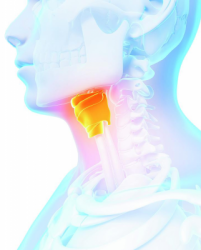

LARYNGECTOMY.NET
Total laryngectomy indications
The indications for total laryngectomy are largely dominated by oncology: cancer of the larynx, pharynx or of the upper third of the oesophagus. The other indications, much rarer, are total laryngectomies with functional target and haemostasis laryngectomies. The following indications have been obtained from the Low Normandy concerning the treatment of upper aerodigestive tract (UADT) cancers, updated in 2014.
CANCERS OF THE LARYNX
The indications of total laryngectomy for cancers of the larynx are the following:
– Glottic area:
– T3: lesion of 3 stages and/or with vocal chord fixation
– not accessible to partial supra-cricoid laryngectomy
– non-response to neo-adjuvant chemotherapy within the framework of a laryngeal preservation protocol
– T4: invasion of adjacent structure
– Supra-glottic area:
– T3 or T4a: if partial surgery cannot be performed
– T4b (invasion of pre-vertebral space) with removable tumor and the patient can be operated
– Sub-glottic area:
– T3:
– TL from the outset
– non-response to neo-adjuvant chemotherapy within the framework of a laryngeal preservation protocol
– T4: invasion of adjacent structure
CANCER OF THE HYPOPHARYNX
– Classification :
– T3: one or several regions with modification of the mobility of the larynx or size > 4cm
– T4a: invasion of cartilage, hyoid bone, thyroid gland, oesophagus, central compartment soft tissue
– T4b: lesions in pre-vertebral fascia, carotid and mediastinal structures
– Piriform sinus, T3 or T4:
– Total pharyngo-laryngectomy from the outset
– Non-response to neo-adjuvant chemotherapy within the framework of a laryngeal preservation protocol
– Continuation of progression or recurrence after CCR
– Retro-crico-arytenoid region, posterior pharyngeal wall and oesophageal mouth, T3 T4:
– Non-response to neo-adjuvant chemotherapy within the framework of a laryngeal preservation protocol
TOTAL LARYNGECTOMIES WITH FUNCTIONAL OR HAEMOSTASIS OBJECTIVE
These are rare indications of total larygenctomy. The publications in the literature do not allow determining their prevalence.
Tumours of the larynx or hypolarynx that do not require total laryngectomy are usually treated by partial surgery of the larynx or a combination of radiation therapy and chemotherapy.
Partial surgery of the larynx (which may remove the epiglottis, a crico-arytenoid unit, a ventricular band or vocal chord) could result in the appearance of food choking as the primary complication. They are sometimes favoured by an adjuvant or neo-adjuvant radiation therapy, at the origin of repeat pulmonary diseases.
In this situation, and when the pulmonary diseases become too frequent in spite of appropriate speech re-education, there are two options in order to enable a patient to have a risk-free oral feeding. The first is the performance of a tracheotomy with insertion of a balloon cannula, that allows protecting the lower airways. The second option is the performance of a total laryngectomy, that allows isolating the respiratory and digestive tracts definitively.
Radiation therapy may also result in a long-term complication of larynx chronic ulceration, causing repeated bleeding. When the bleeding becomes too frequent and cannot be managed by medical treatment, a haemostasis laryngectomy may be the solution to be proposed.

